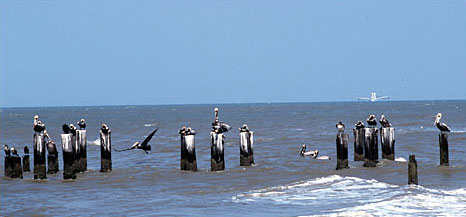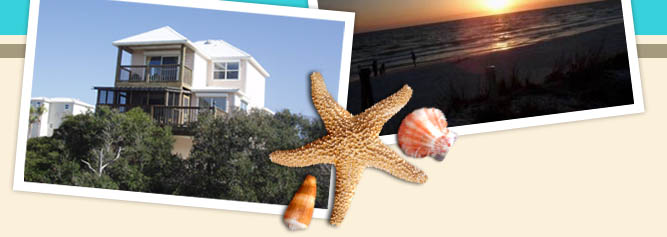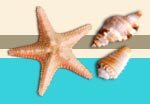|
A Memorably 'Forgotten' Coast
By NANCY BEARDEN HENDERSON

Pelicans in the Gulf of Mexico off Cape San Blas. Photo By Mark S. Wurst
It is just after 7 p.m., and the Indian Pass Raw Bar, a never-been-painted 1929 shack I would have sailed past had I not heard of its reputation as the Cheers of Gulf County, Fla., is already packed except for a couple of stools at the bar. My boyfriend, Mark, and I hastily take the seats, plop down in front of round, black trays brimming with raw oysters, steamed shrimp and crab legs, and wait for our server. And wait. And wait.
Eventually a patron is kind enough to let us in on the "semi-self-serve" policy of this general-store-turned-restaurant: Get your own soda or beer from the glass-front cooler spanning the back wall, nab whoever is handy and give your order, and at the end of the evening, tell the cashier what you consumed. The menu is stark: oysters, shrimps, gumbo and crab legs, all served with two slices of garlic bread and plastic utensils, nothing more. We flag down a waitress, and when our food arrives, I reach across
Mark
, grab a paper towel from the upright roll and dig into my dozen rich and delicious stuffed shrimps.
Before long the friendly local residents, including a man who looks like a red-faced
Ernest
Hemingway
, are regaling us with family histories, fish tales and stories about the famous folks who have allegedly eaten here, from
Sean
Penn
to
Johnny
Cash
and
Lauren
Hutton
. This is where we first meet
Dan
VanVleet
, a likable fellow who will take us to Cape San Blas the next day.
The cape is nothing more than a slender, 20-mile crook of land, never a mile wide, jutting from
Florida
's Panhandle, 35 miles southeast of
Panama City
. Commercialism is limited; there are no fast-food joints here, no shopping malls, not even a hotel. For that, you have to backtrack to
Port
St. Joe
, the county seat famous for its sweet scallops, or head east to
Apalachicola
, a laid-back, historic port with a corner on the region's oyster market.
Cape San Blas is the epitome of what is called
Florida
's
Forgotten
Coast
- raw and untamed except for a scattering of beach houses and docks flanked by thick cabbage palms, magnolias and live oaks. Fiddler crabs scuttle across grassy marshes. An occasional coyote appears beside the road. Bottlenose dolphins cavort year round. The Gulf County Tourism Development Council says the cape is one of the few spots in the state that offers horseback riding rentals on the beach as well as canoeing, bird-watching and snorkeling.
This is the barefoot vacation I have craved after long hours in front of my iMac.
On our arrival, we turn down the road in front of the Indian Pass Raw Bar and veer toward Turtle Beach Inn, so named because of the proliferation of egg-laying green turtles and loggerheads along this unpopulated stretch of shoreline. The community of
Indian
Pass
is a tiny sliver of peninsula stretching east from the Cape toward
St. Vincent
Island
, its 12,500 acres a national wildlife refuge for Indonesian Sambar deer, wild boar and endangered red wolves. For years this was the beach for well-to-do families from
Apalachicola
.
At the inn, we're greeted by a Himalayan cat named Pokey and a chocolate Lab called Turtle. The rambling two-story, four-bedroom beach house, which opened in 1997, is full of creative touches - antique radios, a straw flamingo sporting heart-shaped sunglasses, and turtle sculptures from zany to elegant. Three wooden boats brim with flowering herbs near the oyster-shell driveway. On the wraparound porch sits a heavy church pew that, according to
Trish
Petrie
, the inn's owner, kept lifting off the ground during one of the area's hurricanes and plenty of comfortable rockers that sway in synchronization in the breeze, even when no one is seated in them. If those roosting spots are occupied, there{+rsquo}s always the hammock downstairs, or the old-fashioned porch swing.
We are delighted to find that our spacious suite, furnished with wingback chairs, a baker's rack of books and trinkets and a private hot tub, overlooks the ocean, with two chairs set outside on the second-story wraparound porch. Right now, though, it's time to head for the beach, where a martin house up on a pole welcomes us at the edge of the sand.
Afterward we explore
St. Joseph
Peninsula
State Park
, some 2,500 acres of heavy pine forests and beaches at the northern tip of the cape. The park's sandpipe scrub, pine flatwoods and dunes provide a haven for more than 200 species of birds, including bald eagles, ospreys and endangered peregrine falcons. In autumn, migrating monarch butterflies and hawks stop here on their annual flight to
Mexico
. Soon after we enter the park, the glowing sun dips into the Gulf of Mexico while, on the bay side, the water shines silvery green beyond sands so white they are nearly fluorescent.
On the way to the raw bar, we pause to check out the Cape San Blas Lighthouse, a welcoming beacon in the twilight. A slender steel tower encased in a ladderlike sheath, the landmark is not as impressive as those in New England or
North Carolina
{+rsquo}s Outer Banks, but interesting nevertheless. Built in 1895, the current lighthouse was moved to its present location in 1919 on what is now property tended by the Eglin Air Force Base. Erosion, hurricanes and Confederate soldiers collapsed its four predecessors. In 1996, the Cape San Blas Lighthouse was extinguished and no longer warns mariners of the treacherous shoals that extend five miles into the gulf.
The next morning, we reconnect with
Dan
VanVleet
, a former teacher of English and art who with his wife,
Debbie
, owns Happy Ours Kayak and Canoe Rentals.
Pulling into their driveway next to the shallow waters of
St. Joseph
Bay
, we spot our sit-on-top tandem ocean kayaks, stable craft not prone to roll like their whitewater counterparts. If we have no objections,
Dan
says, we are going to ditch the usual eco-tour route, paddle east toward a remote pine grove and investigate rumors of a bald eagle's nest atop one of the trees.
Mark
and I nod in agreement.
Black's
Island
looms on the horizon as we steer the kayak through a thick, underwater jungle of sea grass teeming with marine critters. We glide past horseshoe crabs, pale pink whelks and an occasional stingray.
Scallops pulse below as
Dan
paddles beside us in his own one-man vessel.
Ahead, silver mullets leap playfully from the bay. At one point, we stretch our legs on a small rise of marshland, where
Dan
shares a few lessons on blue crabs and clams before leading us, first by kayak, then on foot, through increasingly shallow water toward a site south of
Conch
Island
.
Suddenly, we spot them: a lone bald eagle circling the scrub oaks and cypresses, and two smaller mouths quivering from a huge bowl of a nest in the top of a leafless pine. The adult, undoubtedly a protective mom, swirls and swoops, then lands briefly before lifting off and repeating her aerial show. Heeding her warning squawks, we return to our kayaks and drag them away from the shore, but not before
Mark
snaps a few shots of the birds with his Nikon. On the way back, the two men swap places, and with the wind at our backs now, we glide so quickly across the smooth water that at one point Dan asks me to stop paddling. Never at a loss for words, he entertains us with stories, including the one about the annual mullet-tossing contest. "I won until last year," he says with mock disappointment. "They're easier to throw before the wind gets up."
By the time we get back, we are famished. On the way to Beachcomber's, a casual hideaway that serves a rich, creamy crab bisque, another eagle sails across
Cape San Blas Road
, right in front of us, then crisscrosses back toward the sea.
The next day we decide to explore nearby
Apalachicola
, a historic seaside town punctuated by art galleries, shops and restaurants in a pedestrian-friendly merchant district flanking the water.
Established in the early 1800's, Apalach, as it is called locally, once provided the cotton plantations and lumberyards of north
Florida
with an accessible port. During the Civil War, however, the shipping industry suffered greatly. The enterprising residents responded by building a new source of revenue from another rich natural resource, seafood. On this Saturday night, most of the restaurants recommended by our innkeeper and fellow guests, including the Owl Cafe,
Tamara
's Cafe Floridita and Boss Oyster, are crammed with patrons with the foresight to get in line early. We're much too hungry to wait, so we settle for a nonfussy meal at the Apalachicola Seafood Grill, a local hangout with meager furnishings and heaps of scallops, shrimp and the area's famous oysters, as well as memorable Bourbon pecan pie. Back at the inn, we cap a perfect day of nature-watching with a reverent look at the night sky. We skip down to the beach and, lying side by side on the cool, hard-packed sand, point to constellations our fathers had shown us when we were children, hundreds of miles apart.
The next morning, with the car packed, we return to the lighthouse hoping to catch another eagle's nest reportedly spotted on this skinny strip of wild beach. A congregation of imperiled Eastern brown pelicans meditates on wooden-post pews in the gentle surf, odd-looking pterodactyls at rest, as we stroll toward a grove of sparse trees.
Mark
spots it first, then hands me the zoom lens so I can see two baby eagles eating some Sunday brunch. Right on cue, their mother dives close to the cradle of sticks as we tiptoe in its direction. In the past 24 hours, we've seen three adult eagles and four juveniles. Strangely, seven has always been my lucky number.
NANCY BEARDEN HENDERSON is a writer who lives in Chattanooga, Tenn.
|







